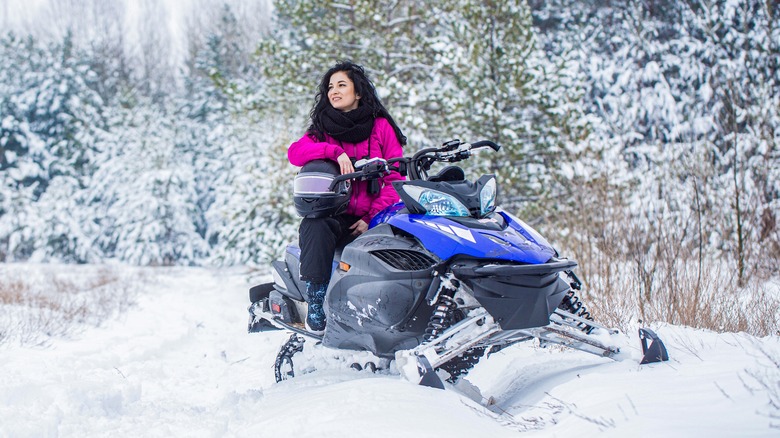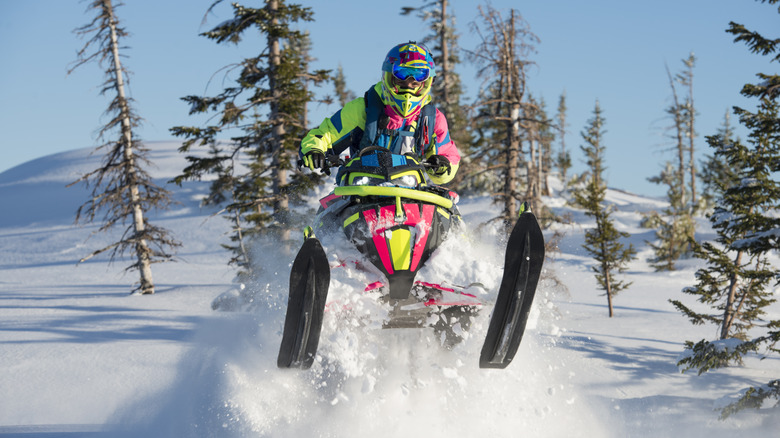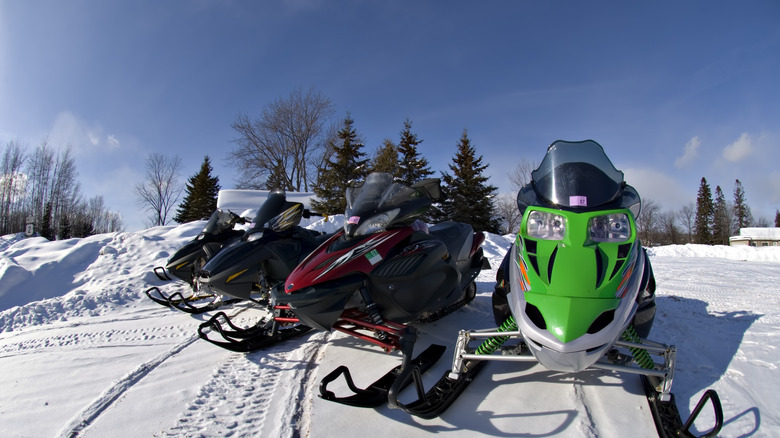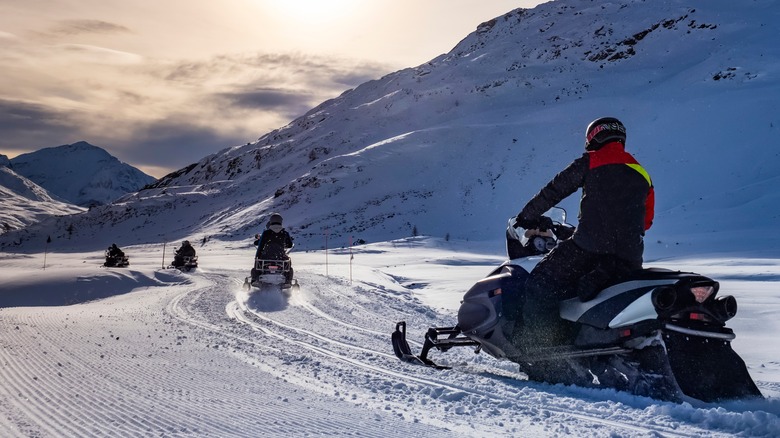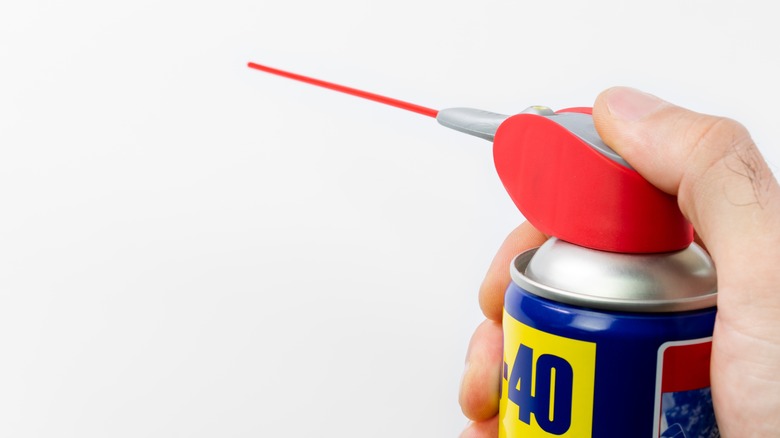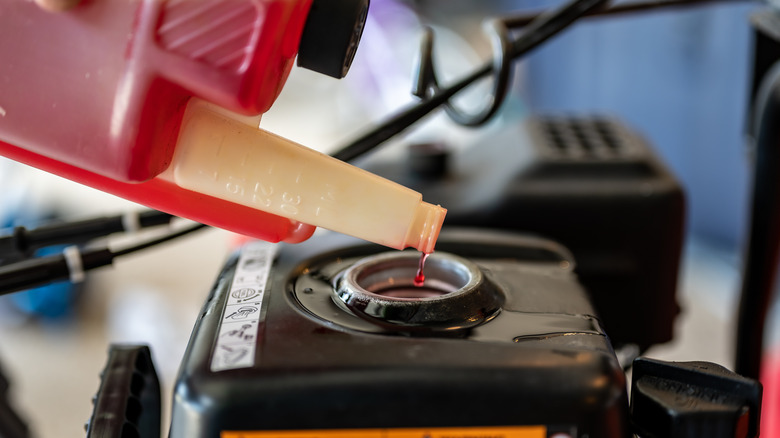5 Tips And Tricks To Maintain Your Snowmobile
Whether you've just experienced a frustrating breakdown on the slopes or are trying to stow away your snowmobile for the next winter, it's a good idea to check your sled for signs of damage and keep up its maintenance. While snowmobiles today are extremely sophisticated machines, they require proper care, as all motorized vehicles do, to remain in peak condition.
Remember that snowmobiles are often subjected to harsh winter circumstances, including rough terrain, snow, and ice, all of which can affect their performance. Timely maintenance will ensure that your snowmobile is ready to hit the slopes safely the next time you plan to ride it. If you notice any signs of damage, it's best to take your snowmobile to a professional mechanic who can address the issues immediately. This, in turn, can extend the lifespan of your sled. Before you do this, however, it's best to inspect your snowmobile yourself. If there's anything that you'd like the mechanic to address or look for, make a note of it.
During your service appointment, communicate your concerns to the mechanic to ensure all necessary repairs are completed to your satisfaction. Be sure to also discuss your snowmobiling habits, including the type of terrain you ride on, and how often you use your sled. If there are no pressing issues, here are a few maintenance tasks you can do to keep your snowmobile in good shape.
Align the skis and check the tracks
All major car wheel brands recommend regular wheel alignment, and the same applies to a snowmobile's skis. Aligning the skis will improve your stability and control while riding, allowing you to navigate the snowy slopes with confidence. Keep in mind that when the skis are properly aligned, they should toe out by a quarter of an inch. Doing this will ensure that the tips of the skis are farther apart than the tails.
You'll also need to check the tracks of your snowmobile. Start the process by looking for worn, cracked, or bent track components, as well as any missing lugs or track clips. If you spot any, replace them immediately. Also, keep in mind that snowmobile tracks don't last forever. If you see serious signs of damage, like worn-out rubber on the track, buy a replacement from a reputable source. You can also check the track tension at this point. Adjusting the tension per the specifications mentioned in your owner's manual will keep your ride safe and improve the longevity of the drivetrain components.
Check the fluid levels
Like most automobiles, your snowmobile needs fluids like oil, coolant, and fuel to function. Due to your usage, these fluids will deplete or degrade in quality over time. It's important to check your snowmobile's fluid levels periodically and top them off as necessary. The frequency with which you'll need to perform an oil change will vary from brand to brand, but it's generally recommended that you change it after 500 miles if you have a new sled and every 2,500 miles from then on.
Be sure to follow the manufacturer's recommendations when choosing the best brand of oil. While you can do this yourself if you have the necessary tools and skills, you can also have it done by a mechanic if you'd prefer. Apart from the oil change, you'll also need to check the coolant level, which is vital to prevent the engine from overheating. Add as much as is needed to keep it at or above the minimum mark on the coolant reservoir. Before you do this, ensure you've parked your snowmobile on level ground and turned the engine off.
Lastly, always keep an eye on your fuel level. Ensure that there's at least sufficient fuel for your next ride so that you don't risk being stranded in a remote area.
Check the suspension
It's vital that you check your snowmobile suspension between uses as well as before you put it away for the off-season. The suspension system helps ensure that you have a smooth journey while navigating tough terrain, so you want to keep it in the best possible shape at all times. If you're considering making any adjustments to the suspension, make sure your snowmobile is on a level surface.
Then, lift the rear end of your sled to check the rear track suspension. You'll want to check the hyfax, also known as slider shoes, to ensure they're not worn down excessively. If they are, you'll need to have them replaced. Next, inspect the rails and springs and check that the shock absorbers are free of leaks and signs of wear. You can also spin the wheels and check the hardware for damage.
You should also check the front free sag and the rear free sag. The front free sag refers to the suspension compression that occurs when there's no rider sitting on the snowmobile. For the front, the compression should, ideally, be about 20% of the snowmobile's total travel. For the rear sag, there isn't a specific measurement, but you can make sure the rear doesn't top out or extend too quickly when you lift it and let it settle.
Clean your sled
Whether you're keeping your snowmobile parked in a garage until next winter or just for a few days, it's important that you give it a good wipe-down. Keep in mind that cleaning your sled from time to time can prevent corrosion and keep it free of debris. Cleaning a snowmobile is fairly easy, given that all you need for the most part is some warm, soapy water. Be sure to rinse under the hood, tunnel, and seat, as these areas can accumulate salt and dirt from riding. You can also use some grease-cutting spray under the hood and an engine degreaser spray near the exhaust ports and oil reservoir.
If you're planning to keep your snowmobile stored for a few months, it's best to take a few preventative measures, like applying WD-40 or a similar product to all exposed metal surfaces and using a recommended brand of grease spray on all the fittings. Use this time to check all the components for signs of rust as well — if you spot any, have the components replaced right away.
After you've cleaned your snowmobile, you're ready to stow it away until you need it. If you're unlikely to use it for a few months, make sure to remove the battery and store it away from sunlight in a temperature-controlled area. You can also remove the drive belt. Leaving the drive belt in your snowmobile can distort the shape and cause rotation issues the next time you use it.
Use a fuel stabilizer
If you plan to store your snowmobile for the off-season, don't make the mistake of draining the fuel tank. Instead, you'll want to fill up the tank with gas till it's almost full. You should also use a fuel stabilizer, which is essentially a solution that keeps the gas from breaking down or evaporating. When you use a fuel stabilizer from a reputable brand, the gas is likely to stay fresh for a number of months, which can help maintain your sled's fuel system during the off-season.
Keep in mind, though, to not just pour a random amount of fuel stabilizer fluid into the gas tank. Instead, you'll want to measure and pour the right amount, which you'll find mentioned in the product instructions. After that's done, it's best to run the engine for a while; this will ensure that the stabilizer is thoroughly mixed with the gasoline. You're now ready to keep your sled parked until next winter.
